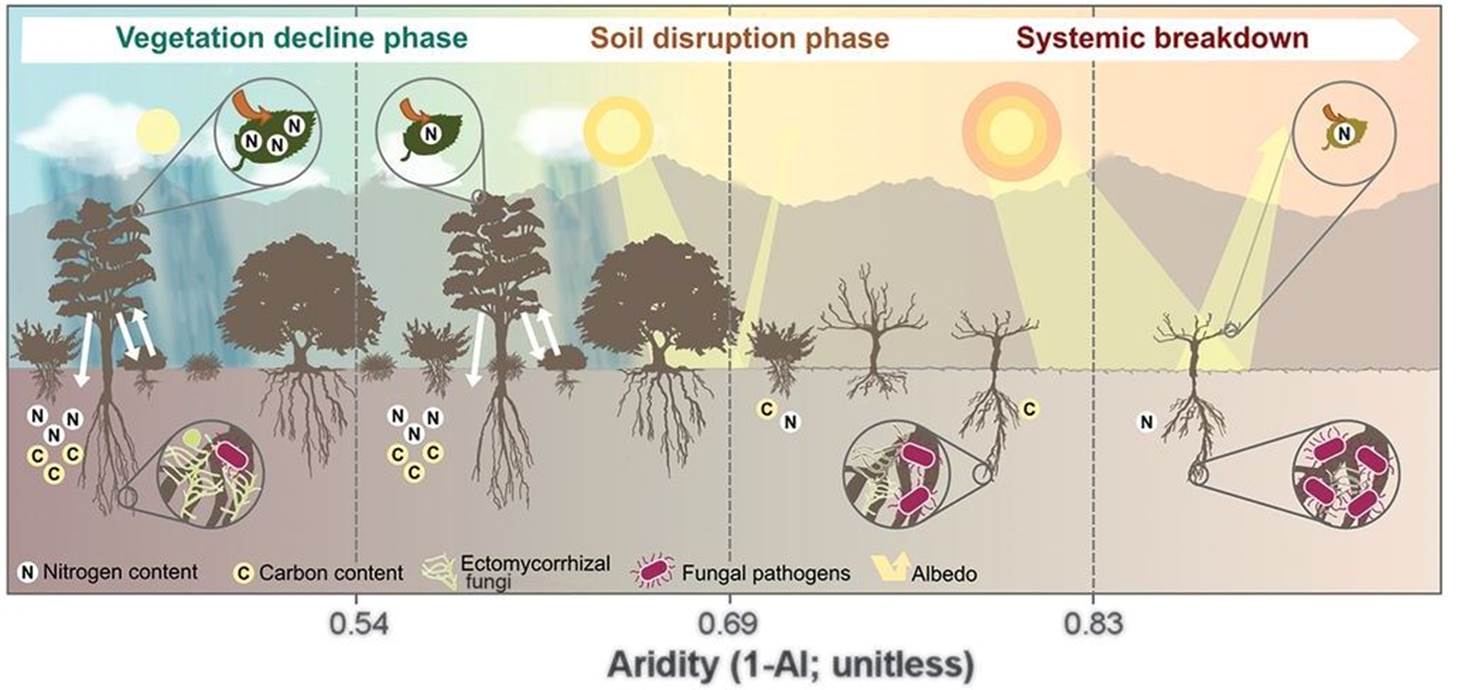These articles are now archived and will no longer be updated.

A Swansea University academic has contributed to a major study published in the journal Science, which shows the increases in aridity in some parts of the world may produce abrupt changes of ecosystems in areas where more than 2 billion people live.
Dr Rocio Hernandez-Clemente, a senior lecturer from the University’s Department of Geography, joined an international team of researchers from the Dryland Ecology and Global Change Lab at the University of Alicante to examine the Earth’s dryland ecosystem, which covers 41% of the world’s surface and is home to around a third of its population.
The study found for the first time that as aridity increases, dryland ecosystems undergo a series of abrupt changes. This results first in drastic reductions in the capacity of plants to fix carbon from the atmosphere, followed by substantial declines of soil fertility and ending with the disappearance of vegetation under the most arid and extreme conditions, creating desert environments.
The study not only has implications for dryland regions but for other areas such as the UK, which while not directly at risk of desertification, will suffer secondary effects such as the recent widespread flooding.
Climate change and ecosystems
The team found that increases in aridity in line with current climate change forecast, may lead to abrupt shifts in dryland ecosystems worldwide which limit their capacity to sustain life. This is because climate largely determines the amount and types of plants that can be found in a given place, how fertile the soil is, and how the landscapes look like. Understanding how changes in climatic conditions affect organisms and the ecosystem processes and services that depend on them, such as food and biomass production, is key to understanding, forecasting and mitigating climate change impacts on both ecosystems and societies.
The study
The team led by Dr. Miguel Berdugo, at the University of Alicante, pulled together the largest compilation of empirical data to date to evaluate how key ecosystems change along the wide aridity gradients that can be found in drylands worldwide. Dr Hernandez-Clemente performed a key part of the data extraction, processing and Normalized Difference Vegetation Index data analysis of 60000 points distributed worldwide and used as an indicator of plant productivity in drylands. She also contributed to the quality assessment analysis and validation of the data and derived trends to detect abrupt shifts through remote sensing data.
Dr. Berdugo said: “The purpose of our work was to look at how these ecosystem change as we move towards more arid zones in order to better understand what we may expect in the future as the climate becomes drier, and more arid, in drylands worldwide.”
The study identified three phases of accelerated ecosystem change in response to increases in aridity, measured as the inverse ratio between rainfall and the rate by which water evaporates from the land to the atmosphere. This index ranges in drylands from 0.35 to 1 and higher values of the index indicate harsher conditions in terms of water availability.
Key findings
The key findings of the study were:
- Key ecosystem attributes and functions in drylands respond in a nonlinear manner to increases in aridity
- If aridity increases beyond a value of 0.5, there is an acceleration in the loss of productivity with further aridity increases.
- If aridity increases beyond aridity values of 0.7, soil loses its structure abruptly and becomes more vulnerable to erosion.
- Soil organisms that play essential roles in maintaining ecosystem functioning are also negatively affected.
- There are large increases in the presence of pathogens at the expense of more beneficial organisms.
- If aridity levels are raised beyond a threshold of 0.8, the system collapses, plants cannot thrive and the land becomes desert.
According to climatic forecasts, more than 20% of land may cross one or several of the thresholds identified in this study by 2100 due to climate change.
Dr Berdugo said: “Life will not disappear from drylands with forecasted aridity increases, but our findings suggest that their ecosystems may experience abrupt changes that will reduce their capacity to provide ecosystem services more than 2 billion people, such as soil fertility and biomass production.”
Dr Hernandez-Clemente said: “The reduced global ability of the land to sustain life is predicted to become an increasing problem with climate change. This study demonstrates the possibility of detecting abrupt changes and monitoring how land turns into desertification processes with remote sensing data.
“The use of satellite image data helps scientists to monitor, predict and quantify the consequences of the increasing aridity in drylands ecosystems worldwide. International cooperation is essential for assessing land degradation and abrupt shifts. The next steps of our research will be focused in the use of earth observation data for modelling spatial and temporal changes of desertification processes.
“This study also has implications for other countries, such as the UK. This is because desertification reduces the Earth’s carbon storage capacity and increases the reflectivity of its surface, which contributes to climate change and increases the frequency of extreme weather events like torrential rainfall. Thus, the implications of desertification are not only for arid regions but also for very different climate contexts such as the UK, and the severe flooding we have seen recently is evidence of this.”
